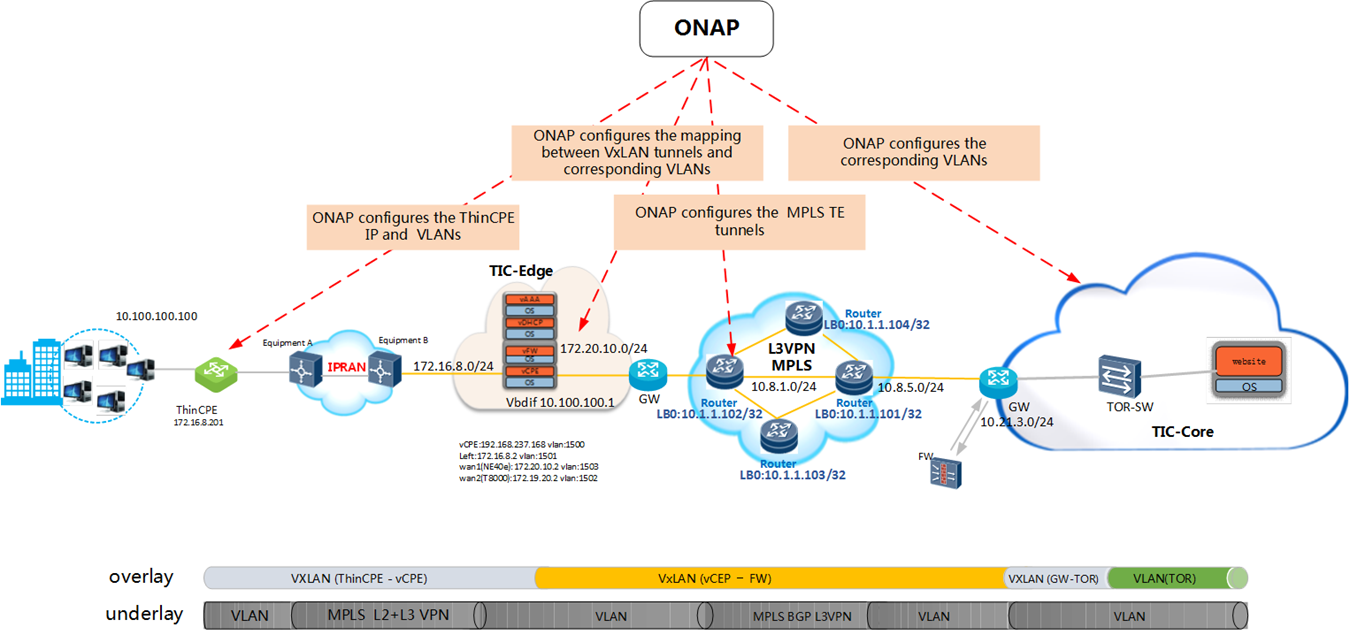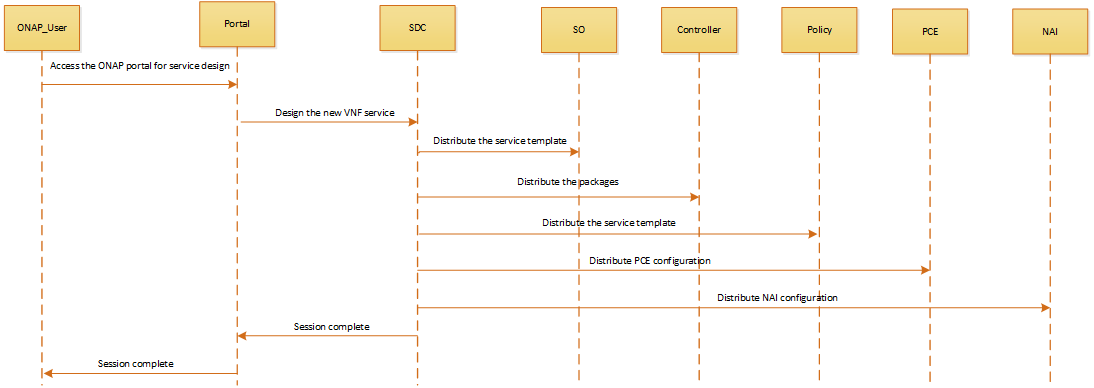Name of Use Case:
Use Case Authors:
China Telecom
Description:
This use case is mainly used for the Enterprise Service Provider (SP) to deploy enterprise-based vCPE to provide the Enterprise2DC service to the tenants both efficiently and safely. Enterprise users could receive high-quality and cheap cloud service based on the operator’s BSS Portal and ONAP. And in here, ONAP is used to instantiate and operate the required vCPE in the access network as a cloud service.
The Operator should first complete provisioning of the Network Infrastructure, and then setup the overlay network connection with VxLAN.
Steps for configuring underlay connection including?
l The Operator: create MPLS L2VPN and L3VPN in the IPRAN Network
l The Operator: create MPLS VPN in the WAN Network
l The Operator: connect the links through VLAN
In this case, ONAP will not only present its function to instantiate, configure and manage the required Enterprise vCPE service but also have the ability to fulfill traffic scheduling in WAN network by means of path calculation and load balancing.
Enterprise vCPE Scenario diagram as shown below:
Users and Benefit:
Enterprise customers would benefit from cloud services and automation either on-premises or in the cloud depending on their branch configurations. This will free the enterprise users from the installation, local configuration and administration of LAN/NAT/WAN/VPN networking.
SPs would benefit from a more flexible platform to provide more kinds of virtual services. To implement the configuration remotely will help SPs reduce complexity of the service deployment and cut down the OPEX.
The centralized traffic scheduling and optimization of backbone network is the embodiment of SDN concept in backbone network, it will help operators enhance the management ability of operation and maintenance and improve the efficiency of resource utilization.
R1 Use Case Flows
ThinCPE's request to get its own IP address for its WAN interface
· ThinCPE send DHCP Discovery message to vCPE for WAN IP
· vCPE store the DHCP Discovery request and then send access request to vAAA
· vAAA reply access accept message,vCPE restore the DHCP Discovery request
· ThinCPE send DHCP Discovery message to vCPE for WAN IP
· vCPE send DHCP Discovery message to vDHCP for WAN IP
· vDHCP sends a DHCP Offer with an address its DHCP server assigns to ThinCPE's WAN IP
· ThinCPE sends a DHCP Request with the offered address to vDHCP
· vDHCP sends a DHCP ACK
ThinCPE's request to get its own IP address for its LAN interface inside the VxLAN tunnel
· ThinCPE send DHCP Discovery message to vCPE for LAN IP
· vCPE send DHCP Discovery message to vDHCP for LAN IP
· vDHCP sends a DHCP Offer with an address its DHCP server assigns to ThinCPE's LAN IP
· ThinCPE sends a DHCP Request with the offered address to vDHCP
· vDHCP sends a DHCP ACK
Once ThinCPE has acquired its own IP address for its LAN and WAN interfaces, it could have access to DC.
ONAP collect link utilization and the actual traffic flows in real-time. when the flow reach the WAN side, the ONAP will conduct the optimal path calculation through configuring MPLS TE tunnels, so as to realize the function of traffic scheduling.
VNF:
Cloud Location | VNFs | Code / Vendor |
Edge | vFW | |
vCPE | ||
vDHCP |
PNF
Cloud Location | Devices | Code / Vendor |
Router | ||
Switch | ||
Server | ||
IPRAN |
ONAP Flows:
- VNFs onboarding
- Service design
- Customer ordering
- Instantiation
- Per service activation
- Cut service
- Self-service
- Tiered bandwidth
- Bandwidth on Demand(future)
- Change internet access bandwidth
- Software management
- Upgrade service
- Upgrade a specific element (VNF) of the service
- Delete service
- Scaling
- Storage (future)
- Auto-healing
- Automatic reboot/restart
- Rebuild
Control Automation:
- Fault detection and correlation between L2-L3 connectivity services and Internet, E2E Link.
- Manage localized enterprise services by automatically performing the health check of the access connectivity, virtual switching/routing and auditing of service-related configurations
- Deliver high availability service requirements for emergency communications and surveillance services
- All control automation should be done on VNFs stood up in the operator’s cloud as well as on the CPE
Project Impact:
- Modeling
The enterprise gateway will typically implement a proprietary VIM. Modeling will need to be added to describe how VNFs are to be instantiated, removed, healed (restart, rebuild), how statistics are gathered, how events are received - SDC
Add logic to use the new modeling when designing the service, and then distribute the resulting artifacts - SO
Add logic to understand the new artifacts; orchestrate/manage changes according to it - SDNC
Add logic to issue the proper commands to the CPE to support instantiation, chaining, configuration, healing, etc. - DCAE
Support statistics collection on the CPE and receipt of events as per the new model - APPC/VF-C and DCAE
Support more complex control loops - SO or SDNC
Monitor the CPE to verify the all VNFs and chaining have been executed, and update A&AI. Is more granular information needed? (e.g. on which vServer each VNF is stood up) - A&AI
Support the new data model - Policy
Support new policy related to the connectivity to the CPE
Work Commitment:
Work Item | ONAP Member |
Modeling | |
SDC | |
SO | |
SDNC | |
DCAE | |
APPC/VF-C | |
A&AI | |
Policy |
Use Case –Enterprise vCPE
Name of Use Case:
Use Case Authors:
China Telecom
Description:
This use case is mainly used for the Enterprise Service Provider (SP) to deploy enterprise-based vCPE to provide the Enterprise2DC service to the tenants both efficiently and safely. Enterprise users could receive high-quality and cheap cloud service based on the operator’s BSS Portal and ONAP. And in here, ONAP is used to instantiate and operate the required vCPE in the access network as a cloud service.
The Operator should first complete provisioning of the Network Infrastructure, and then setup the overlay network connection with VxLAN.
Steps for configuring underlay connection including?
l The Operator: create MPLS L2VPN and L3VPN in the IPRAN Network
l The Operator: create MPLS VPN in the WAN Network
l The Operator: connect the links through VLAN
In this case, ONAP will not only present its function to instantiate, configure and manage the required Enterprise vCPE service but also have the ability to fulfill traffic scheduling in WAN network by means of path calculation and load balancing.



